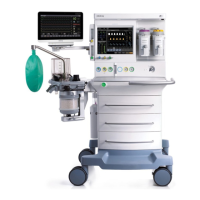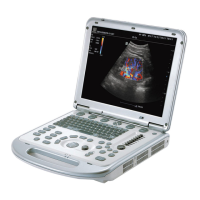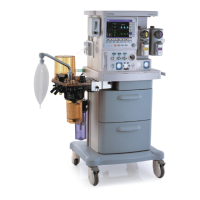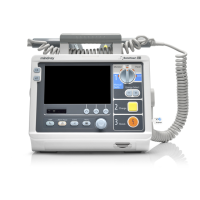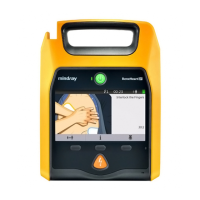A-4
Nebulizer control valve (NCV) is a two-way solenoid valve which has two statuses:
connected and disconnected. Resistor (R1) is an orifice. When NCV is connected,
continuous flow of 6 to 9 L/min is produced. Such flow enters the nebulizer through the
connector on the front panel of the ventilator. The nebulizer aerosolizes medication which
enters the respiratory tract with the inspiration of the patient.
The fresh gas produced by the ventilator is delivered to the patient’s lungs through patient
hose.
Expiration valve (EV) is pneumatically controlled. The expiration valve closing pressure is
controlled by PEEP valve and R3. When the control current given by the system to PEEP
valve is zero, the expiration valve is fully open. When the system gives some control current
to the PEEP valve, PEEP produces some flow, which produces pressure together with R3 to
push the expiration valve diaphragm to close the valve port. The patient’s expired gas must
overcome the valve closing pressure to go through the valve port. This dynamic process
finally ensures that the preset pressure goes throughout the patient’s inspiration and
expiration processes. Expiratory pressure sensor (PE) monitors the expiration valve closing
pressure.
Regulator (REG3) at the front end of PEEP is used to stabilize pressure to prevent change of
valve closing pressure caused by change of PEEP front end pressure. SOL3 is a three-way
valve for Air/O2 connection selection. Air is preferred for expiration valve control gas.
When Air is not available or Air pressure is relatively low, O2 is selected to ensure that
expiration valve pressure can be controlled.
During the inspiratory phase, the system gives control current to the PEEP valve to close the
valve at a certain pressure level, so as to ensure that the delivered Air and O2 mixed gas
from the ventilator goes first into the patient. If an accident happens during the mixed gas
delivery process which causes the delivered gas pressure to be greater than the limit
pressure, excess pressure is released from the expiration valve to ensure the patient safety.
During the expiratory phase, the system gives zero control current or relatively small
control current to the PEEP valve, which indicates that the expiration valve is fully open or
produces a certain valve closing pressure. When the expiration valve is fully open, it is
equivalent to the situation that the patient’s expired gas is directly open to the air (same to
the expiration of a normal person). When the expiration valve has some valve closing
pressure (PEEP), it is equivalent to the situation that the patient’s expired gas is always kept
at a positive pressure, which is clinically significant.
